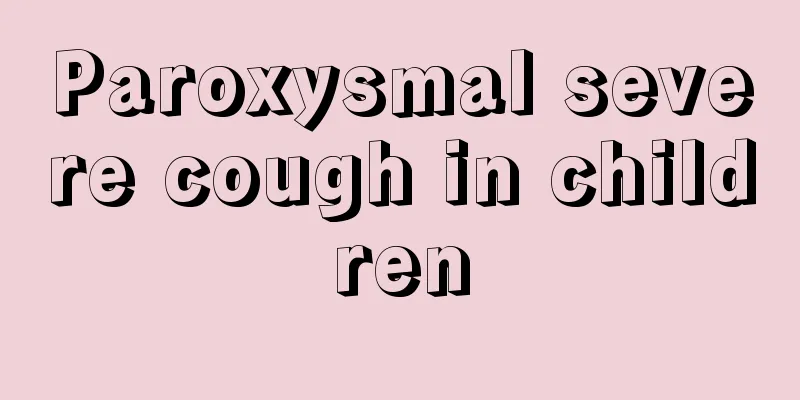Reasons for peeling skin on baby's face

|
It is the wish of many parents that every baby can grow up healthily. However, if the baby is not taken care of during the growth process, some problems are particularly likely to occur. The baby's skin is very delicate, but it is also particularly prone to problems. Many parents will find that their baby's face has peeling, and they are particularly worried about whether the baby's skin is too dry or the baby has a skin disease. Let's understand what is going on with peeling on the baby's face. What is the reason for the baby's face peeling? Infant eczema, commonly known as "milk rash", is an allergic skin disease caused by allergies to foods such as milk, breast milk and egg white. It may also be a skin disease caused by genetic predisposition. If parents suffered from eczema when they were young, their babies are also prone to eczema. A baby's skin is very delicate and even the slightest stimulation can cause the baby's skin to become sick. Infant eczema usually appears between 1 month and 2 years old after birth, and is most severe in babies aged 2-3 months. It often occurs on the cheeks, scalp, forehead, between the eyebrows, neck, under the jaw or behind the ears, and may also spread to other parts of the body. The rash has similar appearances. Some babies have flushed skin covered with yellow greasy scales or scabs, while others have flushed skin covered with rashes and small blisters. No matter which kind of rash it is, it is accompanied by waves of severe itching. Babies often lean on their mothers' bodies and rub against them to relieve the itching until the small blisters break and form large areas of red and moist erosions. At this time, there is a lot of exudate, which can soak clothes and bedding, form scabs after drying, and may also develop into purulent infection or cause swelling of nearby lymph nodes. Milk rash will heal quickly with proper treatment, but it often recurs. Most cases will disappear on their own after weaning, but some cases will take a long time to heal. The rash will be alleviated during fever and aggravated during teething. It is more severe in winter and spring and lighter in summer. After getting ringworm, you should take the following treatment measures: 1. The general treatment principle is: find out the cause, treat the symptoms, feed reasonably, and provide careful care. Generally speaking, we should first observe whether there is food allergy, especially allergy to animal protein such as milk, breast milk or egg white; secondly, the mother can eat fish, shrimp, crab, chicken, etc., which can also be passed to the baby through breast milk. After eating these animal foods, we should observe whether the baby's skin disease worsens. If it is related to the above situation, the baby should change the feeding method; if it is allergic to breast milk, use milk instead, if it is allergic to milk, use breast milk instead, or the mother should not eat fish, shrimp, crab and other foods during breastfeeding. At the same time, the baby's indigestion, constipation and diarrhea should be treated in time. Babies' skin is relatively tender and has poor resistance, so the area should be kept clean to avoid infection. When there is exudation and scabs, do not scrub with hot water or soap to avoid increasing exudate and thicker scabs. Instead, gently apply vegetable oil and do not peel off the scabs forcibly. 2. Commonly used internal medications include diphenhydramine syrup, vitamin B complex, vitamin C, etc. Antibiotics should be added when secondary infection occurs. 3. The topical medication should be determined according to the condition of skin lesions. When there is exudation, erosion, redness or swelling, apply wet compress with 2% boric acid solution or 0.1 reflavonoid solution. After the exudation and erosion disappear, apply topical corticosteroid preparations, such as eczema cream, dehumidifying oil, skin relaxing cream, etc. 4. During the period of infant eczema, do not vaccinate against smallpox (smallpox has disappeared and smallpox vaccination is no longer used), and do not come into contact with people with herpes simplex to avoid herpes. The above is an introduction to what causes peeling on the baby's face. After understanding it, we know that there are many reasons for this phenomenon. We must grasp the cause and prescribe the right medicine. Don't apply some ointment to the baby as soon as you encounter such symptoms. Many ointments contain a large amount of hormones that have certain side effects on the baby. In addition, we must ensure that the air in the baby's environment is not too dry. You can put a humidifier appropriately. At the same time, we should also pay attention to protecting the hygiene and cleanliness of the facial skin. |
<<: What to do if your child's fingers turn white
>>: When is the best time to do circumcision surgery on children?
Recommend
What are the methods to treat cerebral palsy in children?
The number of children suffering from cerebral pa...
What should I do if my baby has phlegm and snores in his trachea?
Children are the most susceptible to colds in lif...
Baby's eyes are a little squinting
If you find that your baby has one eye strabismus...
Treatment for babies who are easily startled when sleeping
Many people's children, especially newborn ba...
Treatment for 8-month-old baby crying at night
An 8-month-old baby cries before going to bed at ...
Three-month-old baby received pain-relieving and anti-inflammatory injections
A three-month-old baby is relatively young, and h...
When can a baby's head stand upright?
We all know that babies are usually held horizont...
What happens when children have fever and diarrhea?
Nowadays, various common pediatric diseases are t...
Causes and treatment suggestions for five-month-old baby's yellow urine
Even if we are talking about normal people, we kn...
The best way to treat epilepsy in children
Diseases that children suffer from should not be ...
What to do if a child has a runny nose?
Children's physical health is very vulnerable...
What are the standard height and weight charts for 1-year-old babies?
When the baby is growing, the standards for each ...
What to do if children have vitiligo
Children are more vulnerable to diseases in life,...
What are the dietary methods for treating indigestion in children?
Indigestion is relatively common in children. It ...
My newborn baby keeps crying and won’t sleep. What’s going on?
As a new mother, you don’t have much experience i...









